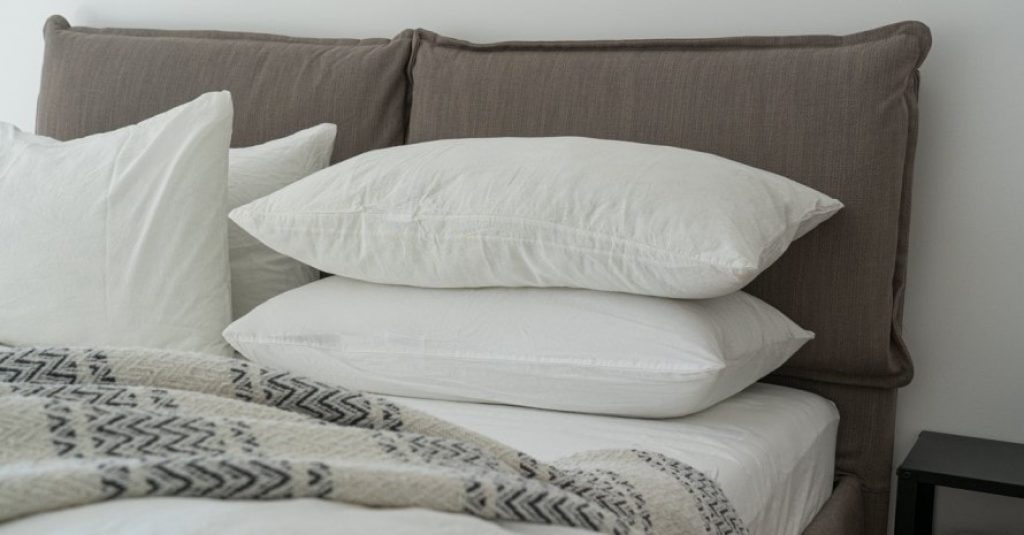Before the textile industry, people did not use pillows while sleeping. Some may think that sleeping on pillow is unnatural to our body’s anatomy. After all, people have never put anything under their heads while lying down before. Today, it’s impossible to imagine a comfortable sleep without a pillow.
I have done many researches and studied the subject of sleep to determine how many pillows should you sleep with and whether you should use this subject at all. A few years ago, I had insomnia. Even after a night’s rest, I felt tired and lacked energy. As it turned out, the wrong number of pillows and the wrong pillows themselves were the cause of my problem.
Now I know how to choose pillows for sleep and what size they should be. The comfortable rest is determined not only by their quantity and filling material. Sleeping with two pillows earlier seemed like something wrong and uncomfortable to me. But I changed my point of view after learning about the anatomy of the body.
In this article, I will share my knowledge and experience. It will help you understand how to sleep on a pillow and how to choose the right product for your sound sleep.
What is a Pillow

A pillow is soft bedding that is placed under your head while you lay down. Most often, this element has a rectangular or round shape with a soft filler (down, feather, synthetic cushioning material). The outer cover is most often sewn from anti-allergenic cotton fabric. A few decades ago, the pillows were filled with a real feather or down. But then the allergen was replaced by artificial materials that do not cause complications, including allergic reactions.
Today, the popularity of so-called anatomical pillows that support the shape of the head in a natural, curved position is increasing. This is necessary to relieve tension from cervical muscles and vertebrae, as well as to relax the upper back. The correct head position and height are essential for comfortable rest and deep sleep.
A couple of years ago, I might have thought about why do we need pillows. But now I don’t ask that question, as I have thoroughly studied the subject of anatomy and body position during sleep. For a good rest, the spine in the area of the back and neck should be flat (180 degrees, without curves).
In this position, the head always tilts slightly forward instead of tilting back. Without sleeping propped up pillows, our head would tilt sideways or backward, depending on the position of the body. This would curvature the spine in the neck area to 50-60 degrees.
Because of the unnatural position, the neck and upper back muscles are always in tension. Not surprisingly, you may feel headaches or heaviness in the head area in the morning.
Pillows are tilting the head back or sideways while sleeping increases the risk of compression of arteries, vessels, and veins. This increases blood pressure, makes you feel unwell, and makes you short of breath and exhausted even after rest. Pillows are needed to level the head so that the spine does not bend, and the upper body muscles are completely relaxed.
What Types of Pillows Are There

When choosing a pillow, we learn about three types of this product:
- Classic;
- Anatomical;
- Orthopedic.
Classics, as you can guess, are the ones we are used to since childhood. They are the usual square or rectangular shape with a filler inside. Classic pillows are suitable for conservatives who do not seek innovation. Although, manufacturers do combine c tradition with new technology. For example, they use innovative synthetic fillers with a cooling effect, which is sure to be appreciated by people who sweat a lot at night. Such cushions are available in different price categories; among them, it is easy to choose the right level of rigidity and type of filler.
Orthopedic pillows are a real find for people with spinal and cervical diseases. It is a special product, which differs from the classics due to the unique shape. Usually, they are made as a roller or rectangle with a notch. Inside it consists of several layers of elastic material.
Orthopedic products are often confused with anatomical products. The former is designed for therapeutic and prophylactic effect and the latter for the most exceptional comfort during rest. The anatomical pillow also consists of several layers of filler. In shape, it resembles two connected rollers of a different size or two chambers with different volumes. Its uniqueness is that it has a memory effect. During rest, the material takes the form of head and neck. More comfort is hard to imagine!
What Are Pillows Made of
Comfort in use, durability and cost of the pillow will also depend on the filler. Pillows can be filled with natural materials or synthetic:
- Fluff;
- Silk;
- Feather;
- Bamboo fibers;
- Hollowfiber;
- Ecofiber;
- Synthetic Fluff.
It is also worth mentioning the innovative materials used for modern sewing cushions – gel, Outlast, and Cool Zip. Gel products have the so-called “memory effect”. they can easily adjust to the contours and bodyweight of the sleeper.
To get a perfect balance, manufacturers combine materials. This way the combinations can be made of vegetable fibers and animal components, natural and synthetic. In this way, the pillows are of good quality and at a more affordable price.
How to Choose a Pillow for Yourself

A sleep pillow is a personal item that should be selected based on the physiological characteristics of the person who will use it. A proper way to lay on a pillow affects the well-being after the sleep, energy, and appearance of the person. It would help if you did not buy the same pad for all family members.
The first thing you need to know is what position you and your family members prefer to sleep in:
- Lying on your back. It would help if you had a cushion of medium height (8 to 10 cm) with medium stiffness and head recess;
- Lying on your side. In this case, you need rather high and rigid support, which will fill the space between the ear and shoulder and will keep the neck at the proper level. The height of the pillow should be equal to the width of the shoulder – the section from the shoulder point to the base of the neck. You can be sleeping with multiple pillows for convenience;
- Lying on your back. It would help if you had a soft, thin, and almost flat support 6-8 cm high. If during sleep on the stomach pillow as a support for the head is not needed, it should be placed under the stomach, so that there is no pain in the lower back.
- You always turn over. It would help if you had a low and soft pillow that is easy to adjust to different positions.
Do a small experiment to determine the best position for sleep: when you go to bed and feel the nap approaching, lay down on your side, back, and stomach one by one. Assess which position of the body was the most comfortable. For example, if you lay on your side for 20-30 minutes and could not sleep, it means that this is hardly your usual position. Also, pay attention to the position of the body in which you wake up.
Another important point that can be taken from this experiment is to find out the right shape of the pillow. Because it also has to be selected according to the position of the body during sleep. It is easy to know which pads are best to choose in terms of shape:
- For sleeping on the back, it is preferable to choose a not too large rectangular pad with a notch or roll under the neck (if comfortable).
- For sleeping on the side, choose a rectangular pillow with a notch under the neck and a notch under the shoulder.
- To sleep on the abdomen, take a small rectangular or star-shaped pillow.
- If you like to tuck the blanket under your feet or are not used to sleeping alone, then perhaps a pad of unusual shape – a large horseshoe, a large letter “G,” sea horse, will suit you. Besides, pregnant women love to sleep in the hug with such pillows, so they are comfortable and do not interfere with the grown tummy.
Another important question: should you sleep with a pillow of orthopedic type? Another important question: Should I sleep with an orthopedic pillow? Such a pad should be used if you are in the wrong position during sleep or if you feel back pain, tiredness, and lethargy. Orthopedic pillows allow you to take an anatomically correct place while sleeping. But before choosing an orthopedic pillow, I would recommend that you consult your orthopedic doctor.
Is It Possible to Sleep Without a Pillow

It is believed that sleeping on a flat surface is much healthier than on a pillow. However, doctors are convinced that the opposite is true. I agree with the opinion that sleeping without a pad is bad for health and quality of sleep.
Adverse effects of sleeping without pillows (based on my experience and scientific research data):
- Sleeping without a pillow may cause a state of weakness and may also be a major cause of chronic sleep deprivation;
- It is not always pleasant to feel a hard mattress under your head if you sleep on your back. Sleeping without a pillow in this position leads to muscle aches and tightening of the joints. You continuously work hard to support the neck and all its neck sections;
- There is a risk of saliva entering the respiratory tract when the head is below body level. Hence the unpleasant cough and waking up during sleep;
- Laying your hands under yourself instead of the pillow causes numbness. It’s very uncomfortable and painful from time to time;
- The head-down position disrupts the blood circulation In a dream. Circulation is disturbed. There’s swelling;
- Crumpling from the bed linen and mattress in the form of traces on the skin. Yes, that’s right. It’ll take an hour for the face to get back to its healthy appearance;
- Mimic wrinkles;
- Too low ahead position can cause the tongue to fall off. Airway narrowing, snoring provoked;
- Causes osteochondrosis, the disease affects people whose profession is associated with constant stress (masseurs, office workers, dentists). Sleeping on a flat surface makes the situation worse. The neck is in the wrong position, which leads to disturbance and improper nutrition of the muscular tissue.
The statement about the benefits of sleeping without a pillow is true only in one case – if we speak about a small child. As they do not need support for the neck and the absence of a pillow helps to form a correct posture and strengthen back muscles.
The Pros and Cons of Pillows
Choosing pillows for sleep is a whole science that has a direct impact on the physiological and mental health of the person. Learn some interesting facts in favor of full sleep in bed with one or more pillows:
- A pillow is not for the head, but to keep the neck level to level the spine and relieve pressure from the upper body;
- Relax your muscles with the right anatomical support for your spine and neck to keep your morning cheerful and energetic;
- With the right size, density and shape of the pillow, the blood circulation will not be disrupted while sleeping, making you feel good;
- All artificial fillers do not cause allergies and can be used even by people with high sensitivity to feathers, fluff, and other natural materials.
Many people ask me: is it better to sleep with one or two pillows? Just one pad is enough for a comfortable sleep. You can use another one for the comfort of your legs or torso. During sleep, the head should be raised by 8-12 centimeters above the mattress level. This is enough to level the body and align the spine by relieving muscle tension in the back and neck. Several cushions raise their heads 20 centimeters or more, which curves the spine.
The correctly selected cushion has no disadvantages. Learn in this article how high should your pillow be and stick to other recommendations for comfortable sleep.
FAQ

Answers to the most common questions will help you make up your mind – how many pillows do you actually need?
Is it better to sleep with or without a pillow?
You really should sleep with a pillow. It’s necessary because of the anatomy of our bodies. The spine needs to be flat to relax and reduce tension. It’s impossible without a pillow. Place something soft under the head with a height of 8-12 centimeters to relieve pressure from the neck and upper back. Different types of pillows are differently comfortable and useful. Use the tips in this article to choose the best option for your favorite sleep posture.
Is it bad to sleep with multiple pillows?
People often ask me, is it bad to sleep propped up on two pillows? I think that to sleep comfortably, a person needs only one pad under his head that is appropriately matched. You can use a second or even a third pillow, but do not put it under your neck or head. For example, pregnant women cannot do without special pillows with a hole in the abdomen.
People with chronic back pain will also need something to put under their lower back while they sleep. It is sometimes not comfortable at night without a pillow or blanket between your legs if you like to sleep on your side. This is normal, and I support it. The main thing is to choose the right height of one pillow under the head (do not try to put two or more – it is better to buy a new higher model).
How many pillows does the average person sleep with?
According to statistics, the average person uses between one and four pillows during sleep. In doing so, people put them under the head, back, legs, arms, and torso, depending on their body position. I used to always sleep on my side or stomach, but over time I began to feel discomfort in the back area.
Because of this, I had to change my sleep position and remove all the extra pillows that curved my spine and neck. I recommend using one pad under my head and one for my legs or back if necessary. You should not buy more than two different sleep pillows.
Why do doctors ask how many pillows you sleep with?
Choosing the wrong number of pillows can lead to many sleeping and health problems. For example, the high height of several pillows under your head disrupts your blood circulation. This can cause headaches and fatigue in the morning, as the brain is not oxygenated properly. Incorrect pillow selection often causes back and neck pain.
A large number of pillows provoke a curvature in the body, which causes the back and neck muscles to be continuously toned. These factors often lead to other health problems: high blood pressure, fatigue, pale skin, posture curvature.
How many pillows should you sleep with while pregnant?
Doctors recommend sleeping on the left or right side, depending on physiological characteristics and trimester during pregnancy. Use an extra pillow to support your legs and abdomen. This is due to changes in body shape and the emergence of a large belly that needs support. It is one large booster pillow for pregnant women or two pillows (separate for the legs and stomach). Accordingly, during pregnancy in the second and third trimester, use two or three pads during sleep.
How many pillows should you sleep with back pain?
During back pain, you can sleep with two or three pillows, placing one under the head and one under the knees and lumbar area. It is relevant for sleeping on your back. When resting on the left or right side, it is recommended to use a second pillow between your legs, which reduces the load on the spine.
Also read: How to Sleep Without a Pillow?
Now You Know Everything About Pillows
From this article, you’ve learned that sleeping with one pillow under your head is the most appropriate solution for anatomical support of the body. When choosing a bed set, be guided by your favorite posture and physiological features. Remember that the head should rise above the mattress to a level of 8-12 centimeters, which corresponds to the height of one pillow.
How many pillows do you use while sleeping? Why? Share your thoughts in the comments section below!






